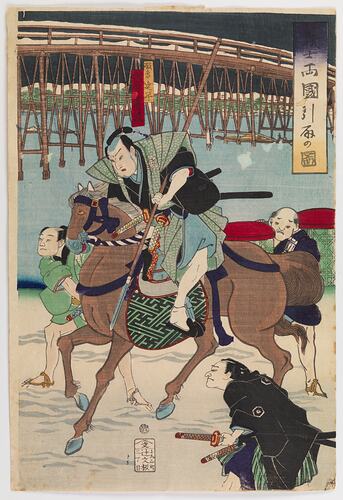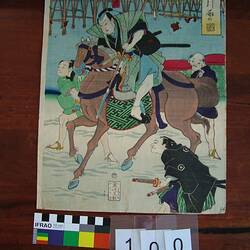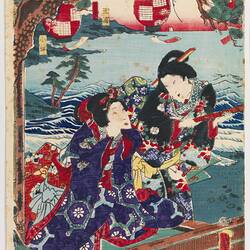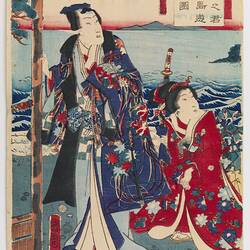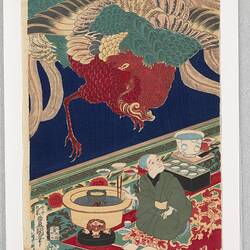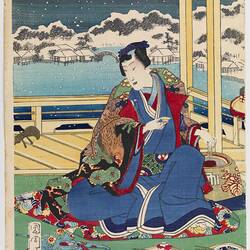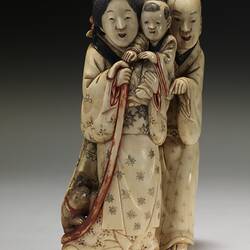Summary
Woodblock print on paper, depicting a scene from the story of the Revenge of the Forty-Seven Ronin, produced by an unknown Japanese woodblock artist and published by Tsujiokaya Bunsuke in Tokyo, Japan, in July 1866. It is possibly a panel of an original triptych; a work of art comprised of three distinct panels.
It was possibly exhibited by a retailer at the Japanese court at the 1880 Melbourne International Exhibition where it was bought by John Twycross.
Woodblock prints like one could have been exhibited under two categories: Class 22, Printed Paperhangings, or Class 42, Toys.
In Printed Paperhangings, G. Inouye from Osaka exhibited 'Printed Paperhangings', Kiriu-Kosho Kuwaisha (now spelt Kiriu-Kosho Kaisha) and T. Akiyama of Tokyo exhibited 'Paperhangings and artistic papers' and M. Tani, Osaka, exhibited 'Printed Paperhangings'. Printed paperhangings, as a nineteenth century term, often referred to wall papers.
In Class 42, Toys, Kiriu-Kosho Kuwaisha and T. Akiyama of Tokyo are listed as having exhibited 'Dolls, Playing Balls, Painted Pictures, &c'. It is more likely that artistic wood block prints such as this one would have been exhibited in this category because of the vivid, graphic subject matter, that so clearly tells a story.
Chushingura is the term applied to fictionalised accounts of the story of the Forty-Seven Ronin, the historical origins of which begin in 1701. A young daimyo, or local feudal lord, Asano Takumi-no-Kami Naganori, had a disagreement with a powerful Edo official of the Tokogawa Shogunate, Kira Kozuke-no-Suke, which resulted in Asano attacking Kira. Such was the disgrace of his actions, Asano committed ritual suicide.
With his death, his retainers were made ronin; that is, samurai without a master. One of them, Oishi Kuranosuke Yoshio, who had been a high-ranking samurai in the service of Asano, led a group of forty-seven ronin to avenge Asano's death. They bided their time for two years, leading Kira to believe they were complacent and disloyal retainers, before breaking into Kira's mansion in Edo, beheading him, and laying his head as an offering at the grave of their fallen master, Asano.
On the way to Asano's grave, the ronin cross the snow-covered Ryogoku Bridge, but are temporarily held back by a Hatamot Samurai, Totori Ippei (also Tottori Itsur, Hattori Itsuro). Being criminals, they were not allowed to go through a main street of Edo. However, the Hatamoto gave a detour to these loyal retainers of Asano.
Having placed the severed head of Kira on Asano's grave, forty-six of the ronin - one had been sent off as a messanger - knowing they faced punishment for Kira's death, committed ritual suicide, and were subsequently interred in the grounds of of Sengaku-ji Temple, in front of the tomb of their master.
The story was a popular subject was for interpretation by Japanese kabuki theatre and woodblock artist would often represent known actors of the story's characters in their own works. It is possible that this representation of Totori Ippei, mounted on his horse with retainers, at the foot of the Ryogoku Bridge, depicts an actor that would have been well-known to late Edo-period audiences.
To many in the Melbourne Exhibition's largely western audience however, the flattened pictorial form and composition of Japanese prints remained puzzling, and often misunderstood. 'The Japanese pictures were very curious, some of the figures being made to rise considerably above the background', the official catalogue to the exhibition observed, while the Argus newspaper - quoted in the official catalogue - commented of the display of porcelain figures that although 'Stamped with character...the human figure more often than otherwise [is] grotesque in position and humorous in expression.'
Physical Description
Unsigned Japanese coloured wood block print on paper depicting Totori Ippei at Ryogoku Bridge in the story of the Revenge of the Forty-Seven Ronin.
More Information
-
Collection Names
-
Collecting Areas
-
Acquisition Information
Cultural Gifts Donation from Dr Will Twycross, 23 Jan 2009
-
Acknowledgement
Donated through the Australian Government's Cultural Gifts Program
-
Place & Date Made
-
Place & Date Exhibited
Royal Exhibition Building (REB), Nicholson Street, Carlton, Greater Melbourne, Victoria, Australia, 1880
-
Collector
Mr John Twycross, Elsternwick, Greater Melbourne, Victoria, Australia, 1880-1881
-
Publisher
-
Inscriptions
Signature (English marking): Drawn by Yoshitora Censor Seal: Aratame (inspected) with Tora 7 Censor Seal (English marking): Year of Tiger, July Date of manufacture: 1866 (End of Edo) Publisher (Hanmoto/Shri-shi): Tsujiokaya Bunsuke Place of manufacture: Edo (Tokyo), Japan
-
Classification
Royal exhibition building, International exhibitions, Exhibition heritage
-
Category
-
Discipline
-
Type of item
-
Dimensions
367 mm (Length), 247 mm (Width)
-
Maximum dimensions
366 mm (Length), 246 mm (Width)
Measurement From Conservation.
-
References
MIE 1880 Catalogue, Japanese Exhibits, p.572 MIE 1880 Catalogue, Introduction to the General Exhibits, Japanese Court, p.cxxi, cxxii
-
Keywords
Exhibitions: Melbourne International, 1880-1881, Folklore, Japanese Art, Japanese Culture, Prints, Royal Exhibition Building, Royal Exhibition Building: History of Events, 1879-1899
